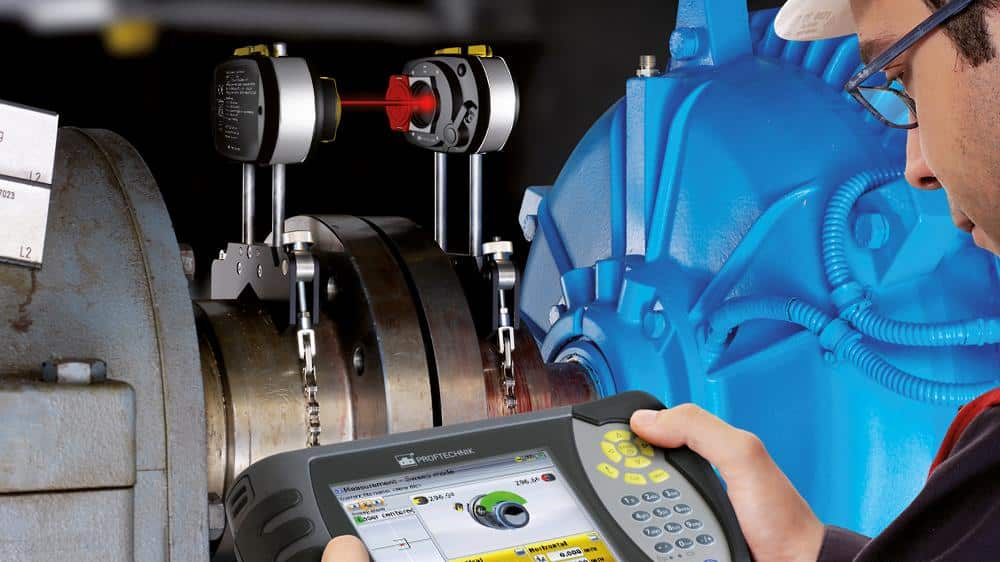
What is a Laser Alignment Tool?
A laser alignment tool is a device that helps identify and correct shaft misalignment. Laser alignment is the quickest, most effective way to achieve shaft alignment across components. It can be used to align motors, shafts, gearboxes, blowers, and other components that use shafts to transfer mechanical power.
1. What are the Benefits of Laser Shaft Alignment?
Laser alignment is much more accurate than traditional methods that employ rulers and dial gauges. Lasers provide precise, consistent information no matter who is doing the testing. Even technicians with little previous experience with alignment can use laser alignment tools.
Laser alignment tools are also quicker to set up than traditional methods. That means technicians need less time to measure and correct alignment issues, resulting in a reduction in downtime.
Other benefits of shaft alignment include reduced maintenance costs, improved asset performance, and increased equipment lifespan. Proper alignment reduces costs for equipment maintenance and replacement while improving the overall efficiency of the plant. It also improves safety for workers by reducing problems such as fuel and oil leakage.
2. How does a Laser Alignment Tool Work?
Laser alignment tools work by firing a laser beam across a machine component, such as a rotating shaft, to measure for alignment. The data is then sent wirelessly to a user dashboard, where users receive real-time feedback as they make adjustments.
Since these tools are intuitive and easy to use, users of all experience levels can employ laser alignment tools to diagnose and fix alignment issues. Some laser alignment tools can also automatically filter out inaccurate data caused by coupling backlash and environmental vibration, allowing a perfect alignment even in less-than-ideal circumstances.
Laser alignment tools can be used for:
- Horizontal alignment
- Vertical alignment
- Machine train alignment
- Soft foot
- Thermal growth
3. Laser Alignment Procedure: How to Use a Laser Alignment Tool
- Ensure the machine is off and that the area is cleared of debris to provide a safe working environment.
- Attach mounting brackets for the laser and the detector unit to either side of the coupling on either the shafts or the solid coupling hubs. Ensure both brackets are at the same rotational position.
- Mount the laser transmitter and the detector unit. If necessary, loosen the mounting brackets to make small adjustments to visually align the transmitter and detector units.
- Ensure the support posts are long enough to allow the laser to fully clear the coupling and reach the detector unit. Both units should be as low as possible while also being high enough to clear the coupling.
- Enter machine dimensions and tolerances as required by the laser alignment tool.
- Turn the laser on. If it is not touching the detector unit, make adjustments until the laser beam is making contact.
- Take the initial measurements. More advanced laser alignment tools also have the ability to take multiple readings as the shafts turn. If using a laser alignment tool with sweeping capabilities, continue taking measurements as the shafts rotate to receive more information about the misalignment and how to correct it.
- Use the information provided by the laser alignment tool to make adjustments to machinery and repeat the measurements until achieving alignment within tolerances.
4. Choosing the Right Laser Shaft Alignment Tool
There are a few key things to consider when choosing the best laser alignment tool for your facility. Here are key features to consider as you decide:
Dual Laser vs Single Laser:
Laser shaft alignment tools may use either a single laser or a dual laser. Lining up both lasers in a dual laser system can be challenging, particularly over long measurement distances. The dual laser system is also more challenging to use for repeat measurements and increases the risk of user error and the need to repeat measurements.
A single laser system is easier to use and takes less time to set up initially. It is easier to repeat measurements and provides precise information along with giving the user the capability to correct most shaft misalignments.
Ease of Use:
In addition to selecting between the easier-to-use single laser system vs. the more difficult dual laser systems, there are other features to keep in mind. Choosing a laser alignment tool that has a clear display, intuitive user interface, and user-friendly software can allow less experienced technicians to perform alignments even without extensive alignment backgrounds.
Intelligent Alignment Software:
Some laser alignment tools come equipped with software capable of filtering out measurements that could affect alignment readings, such as vibrations. This software makes alignment quicker and easier in applications where these incorrect measurements could affect the outcome of the laser’s measurements.
Mobile Connectivity:
For teams that work across many facilities or have multiple off-site locations, connectivity is a key feature to look for. With it, technicians can upload readings and alignment information to the cloud via Wi-Fi, Bluetooth, or an internal network, allowing easy documentation of alignment readings and corrections. Technicians can also troubleshoot together across sites in real-time, so more experienced team members can easily provide feedback or assistance when needed.
Speed and Efficiency:
A quality laser alignment tool can provide quick readings and feedback. More advanced tools can take hundreds of readings during a single rotation of the shafts, removing the need to slowly rotate the shafts and stop rotation for each reading. This provides immediate feedback and reduces downtime by shortening the alignment process.

